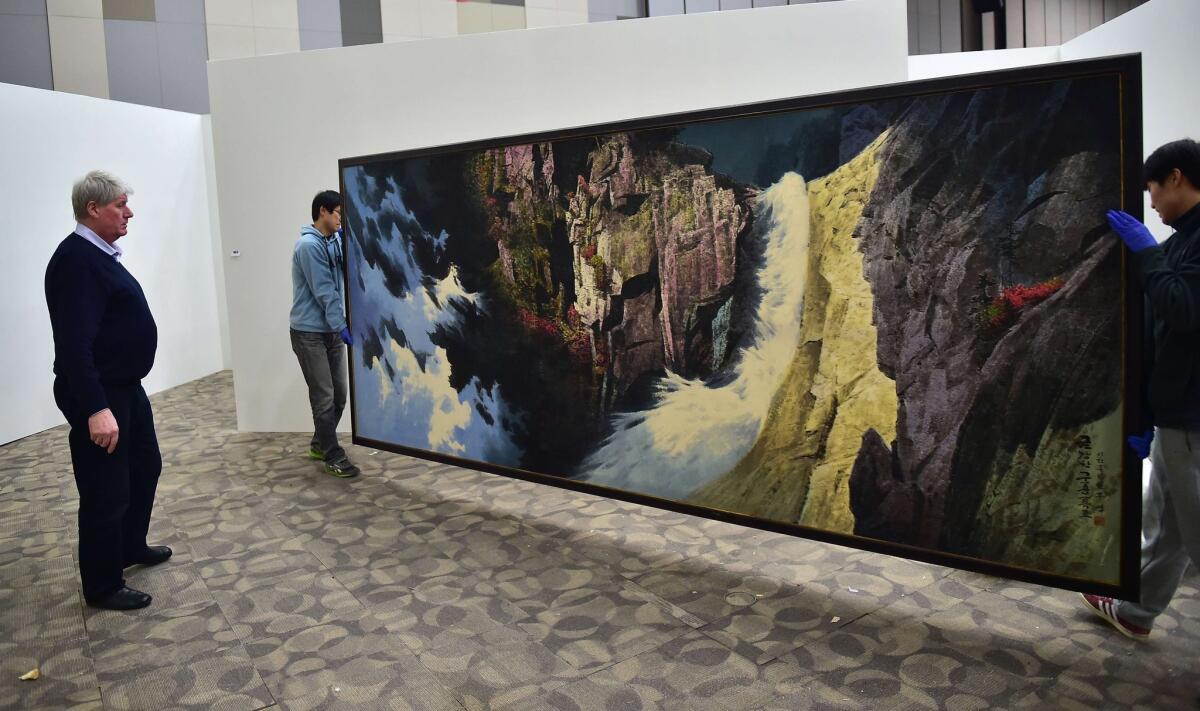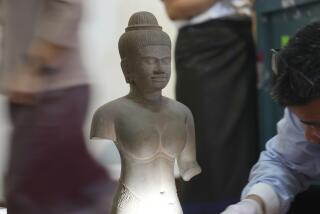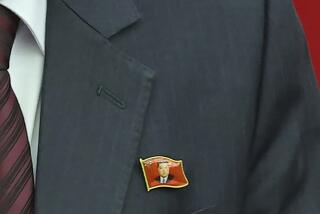South Korea’s ‘Hidden Treasures’ shows another side of North Korea art

- Share via
Reporting from GOYANG, South Korea — Not quite all North Korean art consists of rosy-cheeked farmers and soldiers alongside slogans exhorting the masses to work hard to advance the nation or vanquish imperialists. An exhibition in this satellite city, just several miles south of the DMZ that separates the Koreas, is displaying the nonpolitical side of North Korean art.
The exhibition “Hidden Treasures of North Korea Revealed” is a rare showing of the isolated country’s art in South Korea, where possession of most North Korean materials is illegal, considered by the Seoul government a threat to a fragile postwar peace. Visitors can take in 150 works by 70 North Korean artists, all of which are strictly nonpolitical and arranged according to theme: landscape, portrait, animals and the four seasons.
There is little about the works to mark them as distinctly North Korean. Many depict rugged, mountainous landscape, albeit more colorfully than the widely known propaganda images. Scenes of ponds and mountain trails use a wide range of lively greens not seen in North Korea’s stark political images.
“When we show these works, people don’t even recognize that they’re North Korean,” said Frans Broersen, one of three Dutch collectors who purchased the art from the Pyongyang government and some directly from the artists over a series of visits and curated “Hidden Treasures.”
Broersen says his previous attempts at exhibitions here were not permitted by the South Korean government, which has strict laws on North Korean materials, including the banning of books and access to North Korean websites. “Hidden Treasures” got the government’s go-ahead by pledging to exclusively exhibit nonpolitical works, most of which came through North Korea’s Mansudae Art Studio, which employs hundreds of artists whose energies mostly go to producing works that glorify the country’s leaders.
The most eye-opening pieces for those interested in the mysterious country will likely be works by Gong Cheong Kwon that appear to depict the courtyards of regular North Korean households. Some of those show private vegetable gardens and a range of possessions. Inside the houses are a map of a unified Korea, and a picture of a woman in traditional Korean attire can be seen hanging on a wall, but there are no portraits of the country’s ruling Kim dynasty, which are found in every building in North Korea. Such mundane yet telling details generally don’t appear in any of the state propaganda images.
While the images at “Hidden Treasures” contain no overtly pro-regime messages, there is also nothing in them that indicates the deprivation and repression of human rights widespread in North Korea. All human figures appear content and well fed. The range of emotion on subjects’ faces is narrow, either smiles or contemplation. All mountains are thickly wooded, with no sign of the widespread deforestation documented in the country.
One painting features a woman in a bright-red bikini, unusual for typically prudish North Korea, where women, when not pictured in military uniform, are usually shown in long, loose-fitting skirts and dresses.
That image raises questions over just how authentically North Korean the art being shown at “Hidden Treasures” really is.
Koen De Cuester, who studies North Korean art at Leiden University in the Netherlands, told Agence France-Presse that in his view the bikini image was likely produced specifically for a foreign audience and would never be shown in North Korea. “They produce a lot that caters explicitly to foreign tastes — or what they perceive foreign tastes to be — and the artistic merit of those works is questionable, no matter how well executed,” he added.
Broersen had previously specialized in art from the former Soviet Union but switched to North Korea when prices for post-USSR items rose to beyond his range. Because of North Korea’s bad reputation internationally, some quality art from there is undervalued, he said. He is now hoping that with more exposure, both interest and prices will increase.
“We saw North Korea as a place to acquire some very high standard works at low prices, and we’re now hoping for a return on that investment,” Broersen said.
The works are available for purchase and are being shown at the Korean International Convention Center.
Experts say that because of the peculiarities of North Korea, there are challenges to navigate before the art market there can mature.
“There’s so much idol worship in North Korean art, and the quality is so inconsistent. Having someone to provide an objective assessment of the artwork is needed to ensure credibility,” said Yoon Beom-mo, a professor and specialist on North Korean art at Kyungwon University in Seoul.
More to Read
The biggest entertainment stories
Get our big stories about Hollywood, film, television, music, arts, culture and more right in your inbox as soon as they publish.
You may occasionally receive promotional content from the Los Angeles Times.










